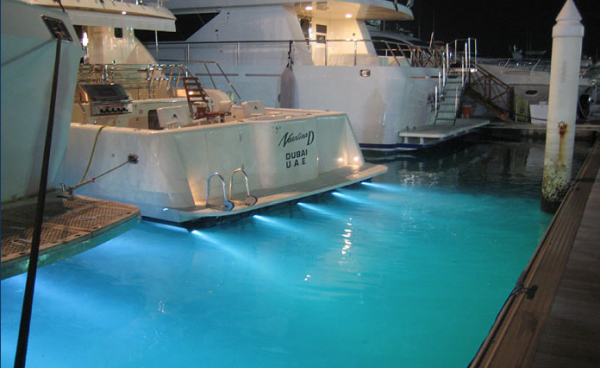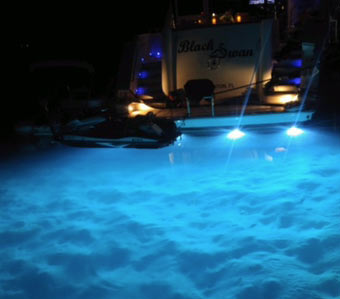Underwater lights: the challenge of retrofit
Underwater LED lighting can bring problems when it comes to retrofits, says SeaVision’s Ian Macdonald…
Regardless of the size or type of boat, it is obvious that underwater lighting has become a standard ‘tick-the-box’ item on any new build. Over the years, as adding underwater lighting has evolved, some potential pitfalls have developed that are often overlooked. Many tech-related issues can be avoided by understanding the history, as well as best practices, regarding the installation of underwater lighting.
In the early days, all yachts’ underwater lights had either HID or halogen lamps. Some were adaptations of swimming pool/submarine lights, while a few were manufactured specifically for boating. As the boating product evolved, gradually standards were applied, together with testing to determine suitability as official ‘class societies’ became involved.
This was a step in the right direction, but as we all know, there was really no standard uniform testing applied to the process. Instead, each class society or individual surveyor created additional requirements to meet their interpretation of the class rules. One example of a requirement that was requested on a regular basis, was the use of additional cofferdams to ensure that, if the primary or secondary cofferdams designed into the light failed, there would be no water intrusion. Although this process added cost, required more space and installation time, it was never really challenged.
With the arrival of LEDs, this practice continued on a sporadic basis. Related issues have escalated to the point where concerns should now be voiced. Traditionally, HIDs projected much of the heat generated during use through the lens, which allowed the water to help with thermal controls. Although additional installed cofferdams contained the heat it did not become a critical problem. LEDs however, tend to emit the heat produced behind the fixture and lens. Contact with water results in less thermal control. Therefore, placing the fixture in an additional confinement (i.e. a cofferdam) retains the heat with some serious potential problems. These problems range from reduced LED life to fire hazards, none of which are desirable. It should also be mentioned that, ironically, when qualifying for any class approval, no testing involving cofferdams is ever completed. Yacht owners specifying LED underwater lights should ensure that the lights specified have approval without additional cofferdams, and verify this with the class surveyor.
The next potential problem results when changing the original lights from HID to LED technology. There are many companies volunteering their products for this purpose, which opens the door for potential problems. The main idea of a retrofit is to change technologies while retaining the original thru-hull fixture. This appears to be a relatively simple procedure that makes sense, but alas may not be so simple. Compatibility of combining the retrofit with the original fixture may be difficult to achieve depending on the ability of the supplier. Real questions should be addressed, regarding less obvious issues that I am sure many not have been considered.
Any installed cofferdams might create thermal problems along with the risks previously mentioned. Regarding most LED installations, the class society should be consulted and the cofferdams removed. Any time class regulations suggest adding a different manufactured product than the original, the complete unit will not be ‘to class’.
While this might go unnoticed, why gamble with safety? If that wasn’t reason enough, this practice could compromise your warranty. Obviously, no manufacturer will offer a warranty on another company’s product. Therefore, it doesn’t take much imagination to guess what might happen if a serious failure was to occur and the warranty was required.
The solution is simple: if you are considering changing your yacht’s underwater lighting to LED from HID technology then my advice is to consider going back to the original product manufacturer and talking to them. While there are retrofit solutions being offered to the market, be careful to ensure you don't end up with a mismatched product. It is far better to be forewarned than to end up sorry later. I hope this simple article will help you avoid any problems that can result from inappropriate underwater lighting installations on your yacht.
We take a detailed look at the subject of retrofitting underwater lighting in the forthcoming issue 184 of The Superyacht Report. Have you subscribed to The ‘new’ Superyacht Report? If you are a captain, owner, yacht manager, chief engineer, first officer, broker, designer, senior shipyard management, an owner’s representative, investor, or a family office, you are eligible for a complimentary annual subscription to the only superyacht industry publication worth reading. To apply for your VIP subscription, click here.
Photos courtesy of SeaVision
Profile links
Click here to become part of The Superyacht Group community, and join us in our mission to make this industry accessible to all, and prosperous for the long-term. We are offering access to the superyacht industry’s most comprehensive and longstanding archive of business-critical information, as well as a comprehensive, real-time superyacht fleet database, for just £10 per month, because we are One Industry with One Mission. Sign up here.





